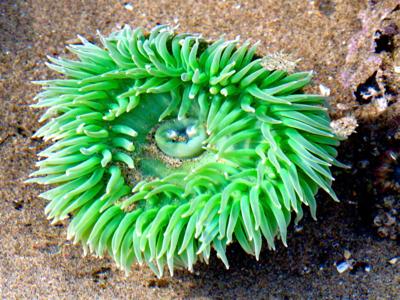Found primarily along the west coast of North and Central America — from Alaska all the way to Panama — the giant green anemone is a favorite for anyone who loves a tide pool.
Clinging readily to rocky shores that host intense wave action, these fascinating creatures are very much at home along our local coastline, and the low tides of summer, with daylight at a maximum, offer the perfect opportunity to enjoy them up close.
Growing up to 12 inches tall and six inches wide, A. xanthogrammica has a tube-like, columnar body, adorned with a crown of tentacles, which, when open and extended, resembles a flowering dahlia or chrysanthemum. These tentacles, which develop in rings, center around the mouth, and are packed with microscopic stinging cells that release a venom strong enough to paralyze prey or help defend against enemies. Don’t worry: The poison is ineffective on humans, and besides, green anemones prefer to dine on sea urchins and mussels, which they digest very slowly before regurgitating the waste back out through their mouths.
Appearing in striking shades of green and bluish-green, the hue of a sea anemone is partly owing to the animal’s unique and symbiotic relationship with a specific algae that lives inside its gut. The algae is allowed to thrive and flourish, and the anemone, in turn, takes extra nourishment from the plant’s process of photosynthesis — all in all, a beautiful friendship. Sea anemones that inhabit shady or deep spaces in the intertidal zone tend to be much paler than those exposed to direct sunlight.
When ocean waters recede and anemones are exposed to open air, they close their tentacular crowns and retreat into a tight little brownish-green bundle that looks like a round sponge. This action helps protect their delicate interior as well as conserve much-needed moisture until the tide turns again.
Mostly a solitary creature, giant green anemones do occasionally appear in groups, and though they can move slowly, using a sort of muscular foot, they tend to stay in one place for their entire lives. In the wild, that can be as long as 150 years.
To learn more about local tide pools, visit oregontidepools.org, and remember: When it comes to these fragile environments, it’s easy to “love them to death.” Look mostly with your eyes, and never, ever, pry an animal off a rock or remove it from its habitat.


(0) comments
Welcome to the discussion.
Log In
Keep it Clean. Please avoid obscene, vulgar, lewd, racist or sexually-oriented language.
PLEASE TURN OFF YOUR CAPS LOCK.
Don't Threaten. Threats of harming another person will not be tolerated.
Be Truthful. Don't knowingly lie about anyone or anything.
Be Nice. No racism, sexism or any sort of -ism that is degrading to another person.
Be Proactive. Use the 'Report' link on each comment to let us know of abusive posts.
Share with Us. We'd love to hear eyewitness accounts, the history behind an article.